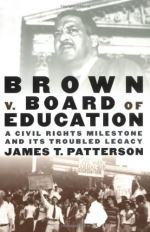|
This section contains 1,802 words (approx. 5 pages at 400 words per page) |

|
Resistance
Some southerners who opposed Brown had a paternalistic feeling toward blacks and did not advocate the violence of racist groups like the Ku Klux Klan. Some in Birmingham were willing to spill blood in their opposition. By the 1960s, moderate whites overcame racist voices and cracked down on Jim Crow. Conservatives were in control in the South; liberals were weak and ineffective. The majority of blacks in the South lacked the vote in the 50s. Blacks were underrepresented in Congress. Much of the judiciary in the South was to emerge as defenders of desegregation. These judges faced anger and even violent reactions from whites in their communities. The Richmond News Leader ran an editorial declaring that Brown had changed nothing. Most white business owners and professional people supported the concept of white supremacy. Governor George Wallace of Alabama was fond of saying, “Segregation now! Segregation tomorrow! Segregation forever...
|
This section contains 1,802 words (approx. 5 pages at 400 words per page) |

|




